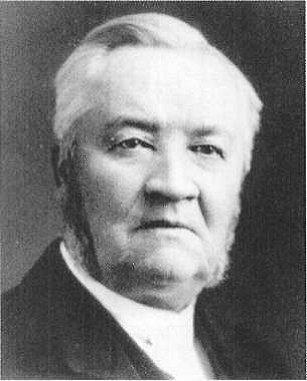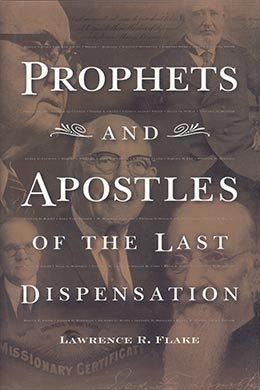Anthon Henrik Lund
Lawrence R. Flake, Prophets and Apostles of the Last Dispensation (Provo, UT: Religious Studies Center, Brigham Young University, 2001), 191–94.

Born: 15 May 1844, Aalborg, Jutland, Denmark
Quorum of the Twelve Apostles: 7 October 1889 (age 45)
Second counselor to President Joseph F. Smith: 17 October 1901
First counselor to President Joseph F. Smith: 7 April 1910
President of the Quorum of the Twelve and first counselor to President Heber J. Grant: 23 November 1918
Died: 2 March 1921 (age 76), Salt Lake City, Utah
A restless group of curious citizens waited in a public building of a small Scandinavian town for the Mormon elders to arrive and address them concerning the new American religion. A snowstorm prevailed outside, and the minutes wore on without a sign of the speakers. A thirteen-year-old boy, who had walked ten miles in the snow to be at the meeting, was perhaps the most nervous person in the congregation. His pride was at stake, for he was a member of this strange new religion and was supposed to help with the meeting. Soon murmurs passed through the crowd to the effect that “the Mormons have fooled us this time.” The boy, Anthon Lund, could remain seated no longer—he stood up, and the crowd instantly fell into deep quiet. He explained the gospel to them with simplicity and power. Several of the congregation later joined the Church and immigrated with the Saints to Utah. [1]
This remarkable and gifted young man was born in Aalborg, Denmark, 15 May 1844. [2] His mother’s death transferred him to the care of a saintly and devoted grandmother who ensured that he had every educational advantage. He entered private school at the age of four and public school at the age of seven. Skipping second grade altogether, he became “first pupil” of the entire school. He learned three foreign languages—English, German, and French. When he was ten, the missionaries came to his grandmother’s home. Anthon, who had read the Bible eagerly since his childhood, knew from the beginning that the doctrines taught by the elders were true. However, anti-Mormon sentiment was so intense in the public schools that it took him two years to make up his mind to be baptized. But on his twelfth birthday he resolutely took the step. The very next year he was called to serve as a missionary and to teach English to the emigrating Saints. It was during this mission that the unusual combination of his youth and competence won him the ear of many listeners.
One devout Lutheran gentleman to whom Anthon tried to preach the gospel was so impressed with the boy’s native ability, great promise, and apparent potential that he told him, “It is too bad that you are a Mormon. If you will study theology at the university in Copenhagen and become a Lutheran minister I will pay the expenses and I will make you my heir.” Elder Lund answered, “I have no doubt you are a rich man, but you have not money enough to buy my allegiance to the Church of God.” [3] Another unusual missionary experience occurred one day while he was out inviting people to a meeting. When he mentioned to one woman that he was a Mormon, a strange look of fury crossed her face; she picked up a pair of fire-tongs and lunged toward him. Years later in a store in Ephraim, Utah, a lady came up to him and said, “‘You do not know me, but I have seen you once. Do you remember a woman who ran after you with a pair of fire-tongs?’ ‘Yes,’ he answered, ‘but you are not that woman, for her face I have never forgotten.’ ‘No,’ she said, I was her neighbor, and seeing her running after you, I asked her what you had done. . . . I became curious to learn something about the Mormons and went to the meeting. I heard you speak and was convinced of the truth.’” [4]
In 1862, at age eighteen, Anthon emigrated to Utah. On board he was elected the company physician, even though he had no experience. Equipped with a single book on common diseases and their cures, the novice physician was much in demand and did a remarkable job. Upon his arrival in Utah he moved first to Fairview and then settled in Mount Pleasant, where he engaged in farm labor. In 1870 he married Sarah Ann Peterson and moved to Ephraim, Utah. The couple had nine children.
Brother Lund held many prominent Church positions, making two missionary journeys to Scandinavia, the second time as president of the mission. Besides being busy with Church callings, he was active in numerous civic capacities, including the Utah legislature, and was also prominent in business, having a hand in countless companies of the time. In 1893 he was called to serve as president of the European Mission and in 1889 became a member of the Twelve. Elder Lund was appointed to succeed Franklin D. Richards as Church Historian in 1900 and was called to be second counselor in the First Presidency under President Joseph F. Smith in 1901. During Joseph F. Smith’s presidency he was called to be first counselor and retained this position under President Heber J. Grant until his death in 1921.
At President Lund’s passing, the Improvement Era noted, “He performed every duty imposed upon him with exceptional ability, faithfulness, and, withal, with the genuine humility and gentleness that are the characteristics of a gentleman and a true Latter-day Saint.” [5]
Notes
[1] J. M. Sjodahl, “Apostle Anthon H. Lund,” Lives of Our Leaders: Character Sketches of Living Presidents and Apostles of the Church of Jesus Christ of Latter-day Saints (Salt Lake City: Deseret News, 1901), 206–7.
[2] Matthias F. Cowley, Prophets and Patriarchs of the Church of Jesus Christ of Latter-day Saints (Chattanooga, TN: Ben E. Rich, 1902), 171–76; Andrew Jenson, Latter-day Saint Biographical Encyclopedia (Salt Lake City: Andrew Jenson History, 1901), 1:161–67.
[3] Jenson, Latter-day Saint Biographical Encyclopedia, 206.
[4] Jenson, Latter-day Saint Biographical Encyclopedia, 207–8.
[5] Sjodahl, “President Anthon H. Lund,” Improvement Era, April 1921, 501.
